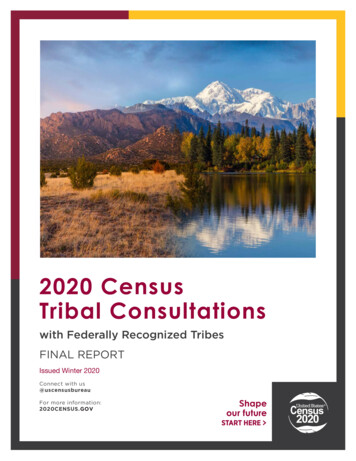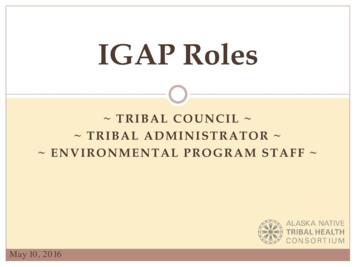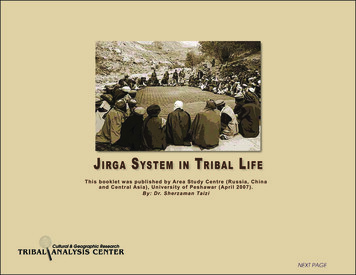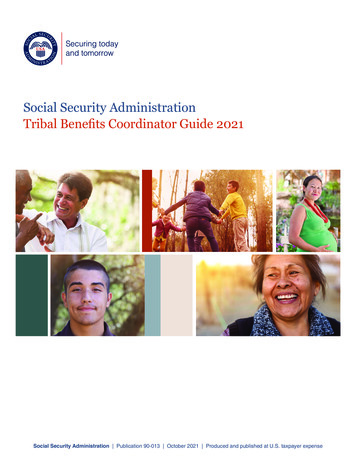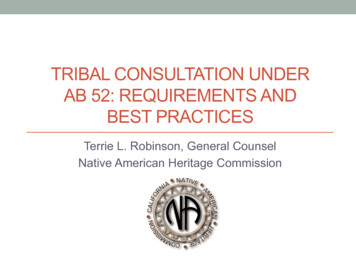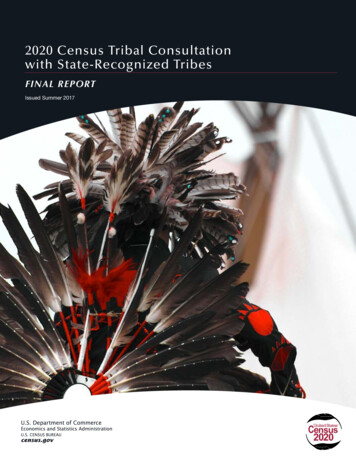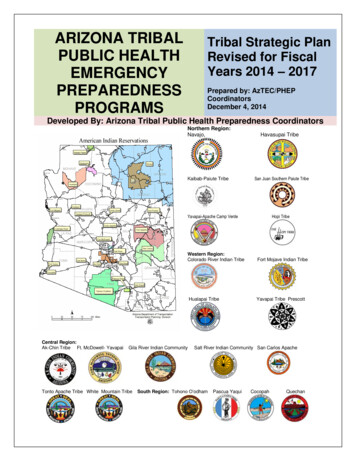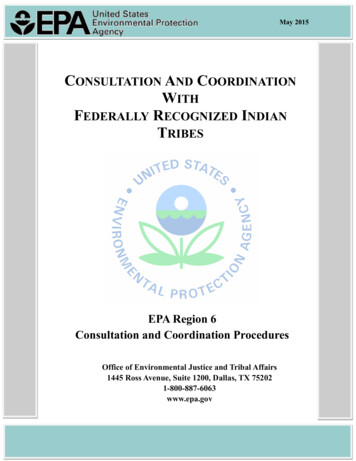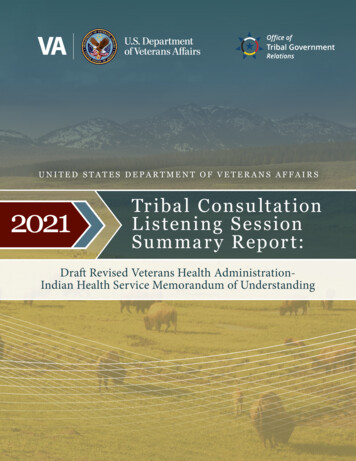
Transcription
UNITED STATES DEPARTMENT OF VETERANS AFFAIRS2021Tr iba l C onsu lt at ionL istening Se ssionSumma r y Repor t:Draft Revised Veterans Health AdministrationIndian Health Service Memorandum of Understanding
Table of ContentsIntroduction . . . . . . . . . . . . . . . . . . . . . . . . . . . . . . . . . . . . . . . . . . . . . . . . . . . . . . 2MOU Background . . . . . . . . . . . . . . . . . . . . . . . . . . . . . . . . . . . . . . . . . . . . . . . . 4What exactly does the MOU do? . . . . . . . . . . . . . . . . . . . . . . . . . . . . . . . . . . . . . . . . . 4Why is the MOU being updated? . . . . . . . . . . . . . . . . . . . . . . . . . . . . . . . . . . . . . . . . . 4Snapshot of MOU Accomplishments . . . . . . . . . . . . . . . . . . . . . . . . . . . . . . . . 5What work has been done so far on revising the MOU? . . . . . . . . . . . . . . . . . . . . . 6MOU Components . . . . . . . . . . . . . . . . . . . . . . . . . . . . . . . . . . . . . . . . . . . . . . . . . 7MOU Purpose and Authority . . . . . . . . . . . . . . . . . . . . . . . . . . . . . . . . . . . . . . . 7Summary of Tribal Input . . . . . . . . . . . . . . . . . . . . . . . . . . . . . . . . . . . . . . . . . . . . . . . . . 7Mutual Goals and Objectives . . . . . . . . . . . . . . . . . . . . . . . . . . . . . . . . . . . . . . 9Access . . . . . . . . . . . . . . . . . . . . . . . . . . . . . . . . . . . . . . . . . . . . . . . . . . . . . . . . . . . . . . . . . 9Patients . . . . . . . . . . . . . . . . . . . . . . . . . . . . . . . . . . . . . . . . . . . . . . . . . . . . . . . . . . . . . . . 11Information Technology . . . . . . . . . . . . . . . . . . . . . . . . . . . . . . . . . . . . . . . . . . . . . . . . 12Resource Sharing . . . . . . . . . . . . . . . . . . . . . . . . . . . . . . . . . . . . . . . . . . . . . . . . . . . . . . 14Operational Planning . . . . . . . . . . . . . . . . . . . . . . . . . . . . . . . . . . . . . . . . . . . . 18Summary of Tribal Input . . . . . . . . . . . . . . . . . . . . . . . . . . . . . . . . . . . . . . . . . . . . . . . . 18Overarching Themes . . . . . . . . . . . . . . . . . . . . . . . . . . . . . . . . . . . . . . . . . . . . . . 19Tribal Inclusion in Future MOU Drafts . . . . . . . . . . . . . . . . . . . . . . . . . . . . . . 19Tribal Involvement in Developing Metrics . . . . . . . . . . . . . . . . . . . . . . . . . . 20Policy Recommendations . . . . . . . . . . . . . . . . . . . . . . . . . . . . . . . . . . . . . . . . . 21Conclusion . . . . . . . . . . . . . . . . . . . . . . . . . . . . . . . . . . . . . . . . . . . . . . . . . . . . . . 22Appendix: Draft VHA-IHS MOU . . . . . . . . . . . . . . . . . . . . . . . . . . . . . . . . . . . . . 23Tribal Consultation Listening Session Summary Report: VHA-IHS Memorandum of Understanding1
IntroductionConnecting American Indian and Alaska Native (AI/AN) Veterans to the benefits theyhave earned through their service is a top priority for the U .S . Department of VeteransAffairs (VA) . To improve access to health care services for Indian Country’s Veterans, the VAVeterans Health Administration (VHA) and the Indian Health Service (IHS) work togetherunder a memorandum of understanding (MOU) to leverage resources and share knowledgetoward the common goal of enhancing care for AI/AN Veterans .Beginning in 2019, VHA and IHS launched a joint effort to engage with tribes about howto best modernize the VHA-IHS MOU, strengthen its implementation, and advance itsmutual goals . The process began with an initial meeting with tribes and urban Indianorganizations (UIOs) in May 2019 .In line with the agencies’ tribal consultation policies and in recognition of the governmentto-government relationship between the federal government and tribal nations, VHAand IHS engaged in tribal consultation and UIO confer on this topic . To initiate tribalconsultation and UIO confer, IHS distributed a letter to tribal and UIO leaders1 onSeptember 4, 2019, announcing an upcoming tribal consultation and a comment periodfor tribal and UIO partners to provide written remarks . The agencies held the initial tribalconsultation session on September 16, 2019 .Based on input gathered through tribal consultation, UIO confer, and written feedback,VHA and IHS developed a draft revised MOU . On December 2, 2020, IHS and VHA jointlyissued a subsequent Dear Tribal Leader Letter2 to share the draft revised MOU andencourage further engagement from tribes around it .To present the draft revisions to tribes and UIOs and gather their feedback directly, VHAand IHS then hosted a series of three listening sessions and two informational sessions onthe following dates . 2Listening session: December 9, 2020Listening session: January 8, 2021Informational session:January 27, 2021 Listening session: February 17, 2021Informational session with UIOs:February 18, 20211RADM Michael D . Weahkee, IHS . (September 4, 2019) . Dear Tribal Leader and UIO Leader Letter .https://www .ihs .gov/sites/newsroom/themes/responsive2017/display objects/documents/2019 Letters/DTLL DUIOLL VA IHS MOU 09042019 .pdf2RADM Michael D . Weahkee, IHS; Richard A . Stone, VHA . (December 2, 2020) . Dear Tribal Leader Letter .https://www .ihs .gov/sites/newsroom/themes/responsive2017/display objects/documents/2020 Letters/DTLL 12022020 .pdfU.S. Department of Veterans Affairs Office of Tribal Government Relations
The listening sessions and the call for written comments were designed as the primaryavenues for interaction and collection of tribal and UIO feedback on the draft revised MOU .Additionally, the informational sessions provided opportunity for questions and commentsfrom participants .The agencies continued to solicit written input concurrently with these sessions, extendingthe comment period to March 2, 2021, per requests from tribes and UIOs . This extensionwas announced in a letter sent to tribal leadership3 on February 5, 2021 . In total, VHA andIHS received 22 written responses from tribes, UIOs, and tribal and intertribal organizationsregarding the draft revised MOU .The goal of the tribal consultation period was to present the draft revisions to tribal andUIO partners and develop a revised MOU document that aligns with tribal needs, voices,and priorities . The outcomes of the listening sessions will help further refine and shape thedraft updated MOU into a tool for strengthening oversight and furthering the MOU goalstoward its ultimate purpose, which is to improve the health status of AI/AN Veterans .This report summarizes tribal input received through the listening sessions, informationalsessions, and written submissions . To clearly align tribal feedback with the correspondingportions of the draft MOU, the sections of this report are organized by MOU components inthe order in which those components appear in the MOU . Components that drew similar oroverlapping feedback are combined, creating the following sections: MOU purpose and authorityMutual goals and objectivesOperational planningEach section begins with a brief synopsis of the MOU component(s), as presented by VHAand IHS during the listening and informational sessions . Following these descriptionsare summaries of related tribal input . In addition to categorizing feedback by MOUcomponent, this report also captures overarching themes that emerged during thediscussions, which include tribal and UIO involvement in MOU oversight; tribal and UIOinclusion in the development of performance measures for the MOU; and several policyrecommendations that apply broadly to the agencies, rather than specifically to the MOU .The report begins with background information about the MOU and the reasons forrevising it, followed by sections that correspond to the MOU components, and concludingwith a discussion of the overarching themes that emerged . Notably, this report serves asa record of what was discussed and recommended during the listening sessions and doesnot speculate on the feasibility of incorporating each suggestion . As such, neither VA norIHS endorses or takes a particular position with respect to the comments .3Elizabeth Fowler, IHS . (February 5, 2021) . Dear Tribal Leader Letter . https://www .ihs .gov/sites/newsroom/themes/responsive2017/display objects/documents/2021 Letters/DTLL 02052021 .pdfTribal Consultation Listening Session Summary Report: VHA-IHS Memorandum of Understanding3
MOU BackgroundVA and IHS have a long-standing collaboration to provide access to services for AI/ANVeterans . First signed in 2003, the VHA-IHS MOU is at the core of this collaboration .The initial 2003 MOU to improve access and health outcomes for AI/AN Veterans wasupdated on October 1, 2010, in alignment with the most current legislation on health carefor AI/AN people: the Indian Health Care Improvement Act, 25 U .S .C . § 1647(a)(2) . Builtupon a decade of successful collaboration, the 2010 version of the MOU further establishedthe mutual goals of advancing collaboration, coordination, and resource-sharing betweenthe two agencies “to improve the health status of American Indian and Alaska NativeVeterans .”In 2019, the two agencies began a collaborative effort to consult with tribes and seek inputfrom UIOs on revising the MOU to further strengthen services for AI/AN Veterans .What exactly does the MOU do?The VHA-IHS MOU is an agreement between VHA and IHS that serves as a policy documentdetailing how to best serve AI/AN Veterans . It created a forum for collaboration betweenthe two agencies to expand and enhance services for this population . Notably, the MOU isnot a transactional document that involves the exchange of goods and services .The MOU also provided a framework for VA and IHS to coordinate to the fullest extentpermitted by law . A significant result of this strong interagency collaboration is the VAIHS National Reimbursement Agreement, under which VA reimburses IHS for direct careservices provided to eligible, VHA-enrolled AI/AN Veterans .Modeled after this successful interagency reimbursement agreement, the VHA THPReimbursement Agreement Program enables VHA to enter into reimbursement agreementswith individual tribal health programs (THPs) . These agreements and processes varybased on each tribe’s goals, such as attaining certain reimbursement rates or negotiatinga telehealth partnership with VA . Due to variance in what services different IHS and tribalhealth care systems can provide to patients, VA and IHS aim to partner in a way thatensures that all components of the system have the flexibility for local coordination .Why is the MOU being updated?In 2019, the U .S . Government Accountability Office (GAO) published a report4 thatcontained a recommendation for IHS and VHA to revise the MOU and related performancemeasures so that they reflect best practices for successful performance measures, includingthe identification of measurable targets . This recommendation served as the impetus forIHS’ and VHA’s initiation of tribal consultation and UIO confer regarding updates to theMOU .44GAO . (2019) . VA and Indian Health Service: Actions Needed to Strengthen Oversight and Coordinationof Health Care for American Indian and Alaska Native Veterans (GAO-19-291) .https://www .gao .gov/assets/gao-19-291 .pdfU.S. Department of Veterans Affairs Office of Tribal Government Relations
Additionally, tribal and UIO input, as well as federal legislation and guidance, contributedto the decision to update the MOU by highlighting an opportunity for VHA and IHS tofurther clarify and fortify this important document . Updating the MOU will more effectivelypromote its mutual goals, resulting in greater alignment with the current environment andmodern considerations, such as telehealth services . Ultimately, these revisions will createenhanced supports for AI/AN Veterans .Snapshot of MOU AccomplishmentsVA has established reimbursement agreements with 116 THPs and a single IHS sitecovering 74 tribes to reimburse for direct care services to eligible AI/AN Veterans . Sincethe program’s inception in 2012, VHA has provided IHS and THPs more than 142 million inreimbursements (as of June 2021) .Additionally, VA’s Video Connect program has expanded access to mental health careservices for rural AI/AN Veterans who receive care from IHS and THP facilities . To furthersupport mental health for these Veterans, VHA is advancing suicide prevention effortsthrough the Tribal-VHA Suicide Prevention program and is enhancing the section on AI/ANVeterans in the VA Community Provider Toolkit .Other successes include the VA Mail Order Pharmacy, which fills prescriptions for morethan 330,000 Veterans each day . This option provides a lower processing cost, comparedwith filling prescriptions onsite at a VA facility, and delivers the prescription directly to theVeteran’s mailing address .Timeline of the MOU and the Growing Need for RevisionsFebruary 2003: VHA and IHS entered into the MOU to collaborate toward improvingaccess to care for AI/AN Veterans .October 2010: The agencies updated the initial MOU . In line with the Indian Health CareImprovement Act5, this iteration leveraged the long-standing VHA-IHS collaboration toclearly define the mutual goal of furthering their interagency coordination and resourcesharing .June 2014: GAO issued a report6 in which it recommended that VA and IHS developa policy or guidance document to delineate specific roles and responsibilities inimplementing the MOU . The report noted that this clarification would help strengthen theMOU’s effectiveness and create accountability . Together, VA and IHS worked to resolve theissues raised in this GAO recommendation, leading to GAO’s closure of the report .5Indian Health Care Improvement Act, 25 U .S .C . § 1647(a)(2) . (2003) . https://www .ihs .gov/ihcia/6GAO . (2014) . Health Care Access: Improved Oversight, Accountability, and Prioritization Can ImproveAccess for Native American Veterans (GAO-14-489) . https://www .gao .gov/products/gao-14-489Tribal Consultation Listening Session Summary Report: VHA-IHS Memorandum of Understanding5
August 2014: As a legislative response to the GAO report’s recommendation, the Veterans’Access, Choice, and Accountability Act of 20147 mandated that VA and IHS (1) engage inoutreach to tribal leaders regarding the opportunity to enter into THP reimbursementagreements, (2) develop performance metrics for evaluating the MOU’s effectiveness,and (3) assess the feasibility of providing services to non- AI/AN Veterans at IHS or THPfacilities .March 2019—Critical event that triggered tribal consultation: GAO issued a report, VAand Indian Health Service: Actions Needed to Strengthen Oversight and Coordination of HealthCare for American Indian and Alaska Native Veterans, which called for the leadership of VAand IHS to ensure that performance measures for the MOU are measurable and modeledafter metrics that are proven to be effective . Because it required a decision or action thatwould affect Indian Country, this recommendation was the impetus for initiating tribalconsultation and UIO confer .May 2019: In response to these directives and recommendations, VHA and IHS initiated ameeting to gather tribal and UIO input on how to best measure the MOU’s performance .Through this discussion, the recommendation emerged to revise the MOU .September 2019: VHA and IHS distributed a Dear Tribal Leader Letter to initiate tribalconsultation on the MOU and held a subsequent tribal consultation on September 16 togather tribal and UIO feedback . The information gathered through this session helpedinform the development of the draft revisions .What work has been done so far on revisingthe MOU?By applying the findings and suggestions that emerged from the tribal consultation andUIO confer process, VHA and IHS created a draft revised MOU that aims to reflect theevolving health care environment and tribal and Veteran needs . The agencies presentedthis draft revision for discussion at the listening and informational sessions in 2020 and2021 . The written comments and listening session input summarized in this report willfurther inform and shape the draft MOU that was created based on tribal consultation .See the appendix for the full text of the draft revised MOU .76Veterans’ Access, Choice, and Accountability Act of 2014, Public Law 113-146 . § 102 . (2014) .https://www .govinfo .gov/content/pkg/PLAW-113publ146/pdf/U.S. Department of Veterans Affairs Office of Tribal Government Relations
MOU ComponentsThe primary components of the MOU are as follows: PurposeAuthorityBackgroundMutual goalsMutual objectivesOperational planningDuring the listening sessions, VHA and IHS staff delivered brief presentations on eachsection of the MOU and elicited tribal feedback after each presentation . In this report, theMOU background appears above for context . Consecutive MOU components that drewsimilar or overlapping input are combined, resulting in three report sections: Purpose and authorityMutual goals and objectivesOperational planningEach of the following sections begins with a brief overview of the MOU componentfollowed by a summary of related tribal input .MOU Purpose and AuthorityThe primary purpose of the MOU is to create a collaboration framework through whichVHA and IHS can build mutual goals and leverage shared resources to promulgate thosegoals . Both agencies are wholly committed to engaging with tribes and UIOs to ensurethe MOU and any related agreements and actions honor tribal sovereignty, address tribalconcerns, and fit the needs of individual Veterans and their families . Based on the MOUframework, VHA entered into a national reimbursement agreement with IHS and numerouslocal agreements with individual THPs to meet the needs of Veterans and their families atthe local level .Summary of Tribal InputTribal and UIO feedback highlighted the importance of acknowledging and affirmingtribal sovereignty within the wording of the MOU . Specifically, commentors referencedupholding the federal trust responsibility and honoring tribal data sovereignty . Further,they recommended providing education to VA on tribal issues and ensuring that the MOUaligns with key legislation .Tribal Consultation Listening Session Summary Report: VHA-IHS Memorandum of Understanding7
One of the respondents recommended updating the language of the Purpose section toclarify which activities will promote collaboration between agencies .Acknowledging Tribal Sovereignty and ContributionsSeveral tribal and UIO comments urged the specific mention of tribes, UIOs, tribal healthorganizations, and tribal consortia in the MOU’s Purpose section to acknowledge theirsignificant role in providing health care to AI/AN Veterans . Tribal health providers wasproposed as a subsequent term that is inclusive of all these entities after their initialintroduction in the document . Further, respondents specifically commented that thefederal government’s trust responsibility to tribes, which includes providing health care forAI/AN people and honoring tribal sovereignty, must be clearly articulated throughout .Upholding Data SovereigntyFully honoring tribal sovereignty includes upholding tribal sovereignty over themanagement and sharing of data . Several respondents recommended updating thelanguage of the MOU to ensure that it references and promotes “tribal data sovereignty .”Educating Federal PersonnelListening session participants encouraged VA to educate all levels of employees and policyofficials on issues specific to Indian Country, including tribal sovereignty, the governmentto-government relationship between the federal government and tribal nations, and theunique features of the Indian health care system . Such education will equip VA staff toprovide culturally competent services and policymakers to ensure that policy decisions donot adversely affect tribes .Aligning with Recent LegislationSeveral recommendations entailed determining how to reflect and uphold recent keylegislation within the revised MOU . They cited three laws and one bill for consideration: 88The Native American Veterans PACT Act8S . 524: Department of Veterans Affairs Tribal Advisory Committee Act of 2019The Proper and Reimbursed Care (PRC) for Native Veterans Act (P .L . 116-311)Johnny Isakson and David P . Roe, M .D . Veterans Health Care and Benefits Improvement Act of 2020 (P .L . 116-315)This bill, which was passed under Section 3002 of the Johnny Isakson and David P . Roe, M .D . VeteransHealth Care and Benefits Improvement Act of 2020 (P .L . 116-315), prohibits the collection of co-payments by VA from AI/AN Veterans .U.S. Department of Veterans Affairs Office of Tribal Government Relations
Mutual Goals and ObjectivesThe draft updated MOU contains four goals, each with corresponding objectives . To create theflexibility for broad federal collaboration, these updated goals were consolidated from the fivegoals articulated under the current iteration of the MOU . These broad goals pertain to: AccessPatientsInformation TechnologyResource SharingTribal comments on the mutual goals and objectives are categorized by goal in thefollowing sections .AccessGoal: Increase access and improve quality of health care and services to the benefit ofeligible AI/AN Veterans served by VHA and IHS . Effectively leverage the strengths of VHAand IHS at the national, regional, and local levels to afford the delivery of timely, optimalclinical care .Objectives: Build on the successes of the 2010 MOU through performance monitoring andregular meetings .Develop, coordinate, and expand new ways to connect facilities operated by VHA,IHS, THPs, and UIOs .Summary of Tribal InputTo connect AI/AN Veterans to care, tribes and UIOs emphasized the importance offacilitating access to services by acknowledging urban clinics in the MOU, providingtransportation solutions to mitigate challenges in geographic distance, and revising theprescription refill process as outlined in the MOU .“The federal government has a dual obligation to Native AmericanVeterans who have pre-paid for their healthcare, both through thecession of tribal homelands and resources, as well as the defense of ournation. All barriers in access to critical health care services for NativeAmerican Veterans must be viewed as a violation of this obligation.”– Written FeedbackTribal Consultation Listening Session Summary Report: VHA-IHS Memorandum of Understanding9
Including Urban Indian OrganizationsVeterans often choose to visit UIOs, either as their primary providers or as parts of theircare teams, and these partnerships need to be seamless to promote access to quality carefor Veterans based on their needs, rather than expecting the Veterans to conform to afragmented system . VA has worked to cultivate relationships at the local and national levelsbetween VA offices and UIOs . Through these partnerships, outreach events are held to helpVeterans enroll in benefits and file claims . However, as one commentor noted, “UIOs [had]largely been left out of this agreement until recent legislation9 made it clear that UIOsshould be treated as full partners in the MOU .”Several respondents urged VA to continue to be inclusive of these programs and treatthem as full partners within the language of the MOU . They also requested that VA assessthe feasibility of entering into reimbursement agreements with UIOs much like it does withtribal facilities . This request is discussed further under the Policy Recommendations sectionof this report, since its implementation would require policy changes beyond the scope ofthe MOU .“The VA/VHA needs to seriously consider how to be inclusive of UIOleaders to create parity with IHS and THPs.”– Listening Session ParticipantAddressing Transportation ChallengesSeveral participants noted that many AI/AN Veterans must travel long distances to receivecare and urged VA to use the MOU as a basis for addressing transportation concerns for ruralAI/AN Veterans . For example, Navajo Nation Veterans often must travel approximately 300miles to Phoenix, Albuquerque, or Salt Lake City to access VA services . Another participanthighlighted the lack of Veterans’ services across a vast area of northern California betweenSacramento and the Oregon border . These comments underscored the urgency of VA’scurrent efforts to obtain Congressional authorization to expand transportation grantprograms for tribes . A national cross-agency effort to resolve transportation challenges forrural Veterans is essential to creating equitable access to care .910Section 1113 of the Consolidated Appropriations Act of 2021 amended Section 405 of the IndianHealth Care Improvement Act (25 U .S .C . 1645) to include specific mention of UIOs alongside mentionsof tribal organizations in subsections (a)(1) and (c) .U.S. Department of Veterans Affairs Office of Tribal Government Relations
Simplifying Prescription RefillsTo remove obstacles in the prescription refill process, participants recommended revisitingthe prescription refill process and authorizing IHS and THP facilities to fill VHA prescriptionswithin the MOU language . Such clarification would help ensure that patients do not haveto travel long distances to pick up prescriptions or refills .PatientsGoal: Facilitate enrollment and seamless navigation for eligible AI/AN Veterans in VHA andIHS health care systems .Objectives: Improve care coordination processes between facilities .Expand evidence-based training programs for patient navigation specialists .Improve and expand utilization of VHA consolidated mail outpatient pharmacy .Summary of Tribal InputCreating a seamless care experience encourages Veterans to seek and connect with theservices they need . To help Veterans more easily navigate systems of care, tribes andUIOs encouraged VHA and IHS to bolster care coordination across facilities, recognizeand respond to diverse Veterans’ needs, and include traditional healing services underreimbursable activities .Bolstering Care CoordinationTo ensure that AI/AN Veterans can access services that their IHS or THP facility may notoffer, VA maintains a network of purchased referred care (PRC) providers—the CommunityCare Network (CCN) . Strengthening care coordination across THP, UIO, IHS, and VHAfacilities and with any PRC providers is a critical aspect of creating a seamless health careexperience for AI/AN Veterans .VHA and IHS received comments emphasizing the importance of integrating THPs into theCCN through existing VHA-THP agreements without altering the existing reimbursementrates and shared resources under such agreements . However, ultimately, Veterans mustbe able to access care from THPs regardless of whether those facilities are part of a CCN sothey can receive uninterrupted and culturally responsive care .Participants generally expressed support for expanding patient navigation specialiststo help coordinate care and present a seamless experience for Veterans . One participantrecommended that VA station AI/AN Veterans representatives in IHS clinics and THPTribal Consultation Listening Session Summary Report: VHA-IHS Memorandum of Understanding11
facilities to aid communication and care coordination . Further, a process should beestablished for identifying Veteran patients of these facilities to ensure they are notcharged for co-payments .Recognizing Diverse Veteran NeedsVeterans from different service periods have different experiences and needs . For example,best practices for Vietnam Veterans may not translate well for Veterans who served morerecently in Iraq . To ensure appropriate services for diverse Veterans’ needs, commentorsrecommended that VHA provide training for personnel on best practices for each serviceperiod .One participant highlighted the unique needs of AI/AN Veterans who arehomeless and called for the MOU to include a focus on services that aidhomeless Veterans . She described an incident in which belongings were stolenfrom her sister, who has PTSD and is homeless . Unaware of the programs thatmay provide more culturally competent support, she found herself in a statehousing program that did not meet her cultural needs . This story supports theneed for VA to engage in outreach about the programs and options that canassist AI/AN Veterans who are homeless .Additionally, participants highlighted the importance of culturally appropriate services,including traditional healing activities, in providing effective and meaningful care for AI/AN Veterans . This topic is discussed in greater depth under the Resource Sharing goal,below .Information TechnologyGoal: Facilitate the integration of electronic health records (EHRs) and other informationtechnology systems that affect the health care of AI/AN Veterans .Objectives: 12Monitor the development of new Health Information Technology systems .Develop robust Health Information Exchange (HIE) systems .Advocate for increased use of telehealth systems and broadband access in rural
was announced in a letter sent to tribal leadership. 3. on February 5, 2021 . In total, VHA and IHS received 22 written responses from tribes, UIOs, and tribal and intertribal organizations regarding the draft revised MOU . The goal of the tribal consultation period was to present the draft revisions to tribal and

